2011 Peugeot 308 CC warning
[x] Cancel search: warningPage 106 of 292

7
!
i
!
104
SAFETY
BRAKING ASSISTANCE
SYSTEMS
Group of supplementary systems which
help you to obtain optimum braking in
complete safety in emergency situations:
- anti-lock braking system (ABS),
- electronic brake force distribution
(EBFD),
- emergency braking assistance (EBA).
Anti-lock braking system
and electronic brake force
distribution
Linked systems which improve the sta-
bility and manoeuvrability of your vehicle
when braking, in particular on poor or
slippery surfaces.
When braking in an emergency,
press very fi rmly without releasing
the pressure.
When replacing wheels (tyres and
rims), ensure that they conform to the
manufacturer's recommendations.
Operating fault
If this warning lamp comes on,
accompanied by an audible sig-
nal and a message in the mul-
tifunction screen, it indicates a
malfunction of the anti-lock braking sys-
tem which could result in loss of control
of the vehicle when braking.
If this warning lamp comes on,
together with the STOP
and ABS
warning lamps, accompanied by
an audible signal and a message
in the multifunction screen, it indicates a
malfunction of the electronic brake force
distribution which could result in loss of
control of the vehicle when braking.
Emergency braking assistance
System which, in an emergency, ena-
bles you to obtain the optimum braking
pressure more quickly, thus reducing
the stopping distance.
Activation
The anti-lock braking system comes
into operation automatically when there
is a risk of wheel lock.
Normal operation of the ABS may make
itself felt by slight vibration of the brake
pedal.
Activation
It is triggered by the speed at which the
brake pedal is pressed.
The effect of this is a reduction in the
resistance of the pedal and an increase
in braking effi ciency.
When braking in an emergency,
press fi rmly without releasing the
pressure.
You must stop as soon as it is safe
to do so.
In either case, contact a PEUGEOT
dealer or a qualifi ed workshop.
Page 107 of 292
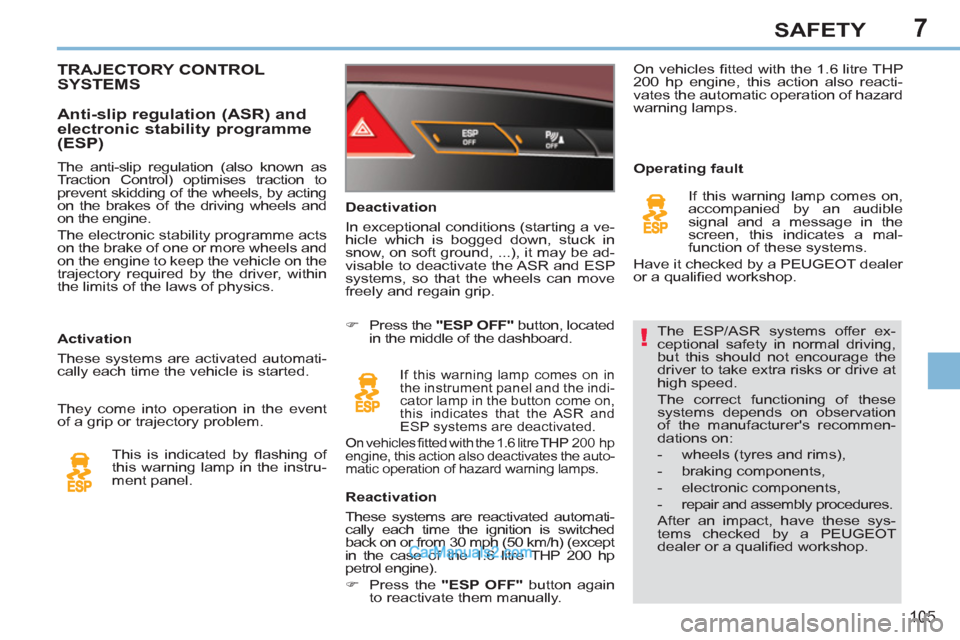
7
!
105
SAFETY
The ESP/ASR systems offer ex-
ceptional safety in normal driving,
but this should not encourage the
driver to take extra risks or drive at
high speed.
The correct functioning of these
systems depends on observation
of the manufacturer's recommen-
dations on:
- wheels (tyres and rims),
- braking components,
- electronic components,
- repair and assembly procedures.
After an impact, have these sys-
tems checked by a PEUGEOT
dealer or a qualifi ed workshop.
Deactivation
In exceptional conditions (starting a ve-
hicle which is bogged down, stuck in
snow, on soft ground, ...), it may be ad-
visable to deactivate the ASR and ESP
systems, so that the wheels can move
freely and regain grip.
�)
Press the "ESP OFF"
button, located
in the middle of the dashboard.
If this warning lamp comes on in
the instrument panel and the indi-
cator lamp in the button come on,
this indicates that the ASR and
ESP systems are deactivated.
On vehicles fi tted with the 1.6 litre THP 200 hp
engine, this action also deactivates the auto-
matic operation of hazard warning lamps.
Reactivation
These systems are reactivated automati-
cally each time the ignition is switched
back on or from 30 mph (50 km/h) (except
in the case of the 1.6 litre THP 200 hp
petrol engine).
�)
Press the "ESP OFF"
button again
to reactivate them manually.
Operating fault
If this warning lamp comes on,
accompanied by an audible
signal and a message in the
screen, this indicates a mal-
function of these systems.
Have it checked by a PEUGEOT dealer
or a qualifi ed workshop.
TRAJECTORY CONTROL
SYSTEMS
Activation
These systems are activated automati-
cally each time the vehicle is started.
Anti-slip regulation (ASR) and
electronic stability programme
(ESP)
They come into operation in the event
of a grip or trajectory problem.
This is indicated by fl ashing of
this warning lamp in the instru-
ment panel.
The anti-slip regulation (also known as
Traction Control) optimises traction to
prevent skidding of the wheels, by acting
on the brakes of the driving wheels and
on the engine.
The electronic stability programme acts
on the brake of one or more wheels and
on the engine to keep the vehicle on the
trajectory required by the driver, within
the limits of the laws of physics. On vehicles fi tted with the 1.6 litre THP
200 hp engine, this action also reacti-
vates the automatic operation of hazard
warning lamps.
Page 108 of 292
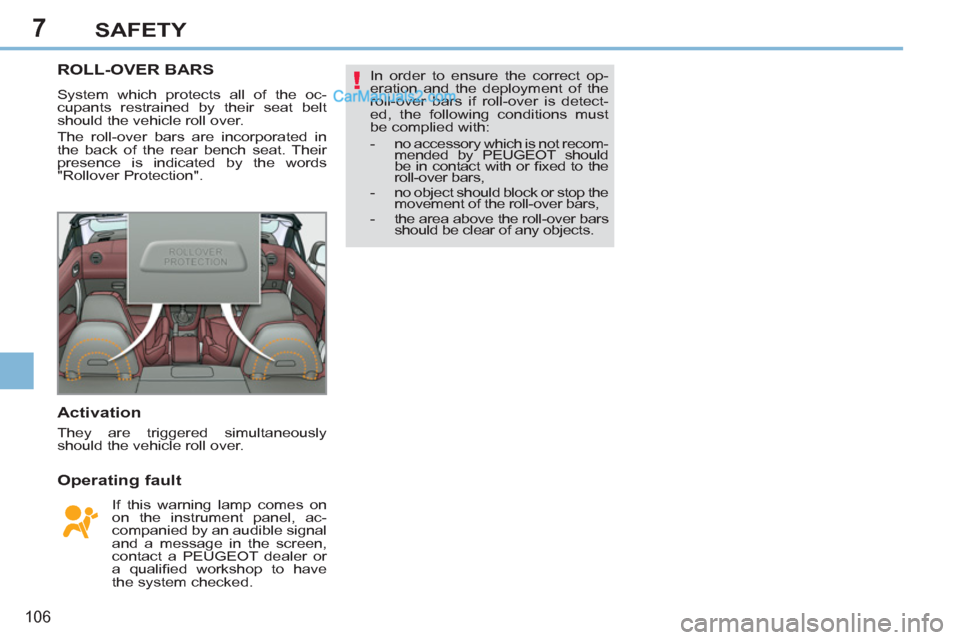
7
!
106
SAFETY
ROLL-OVER BARS
System which protects all of the oc-
cupants restrained by their seat belt
should the vehicle roll over.
The roll-over bars are incorporated in
the back of the rear bench seat. Their
presence is indicated by the words
"Rollover Protection".
Activation
They are triggered simultaneously
should the vehicle roll over.
Operating fault
If this warning lamp comes on
on the instrument panel, ac-
companied by an audible signal
and a message in the screen,
contact a PEUGEOT dealer or
a qualifi ed workshop to have
the system checked. In order to ensure the correct op-
eration and the deployment of the
roll-over bars if roll-over is detect-
ed, the following conditions must
be complied with:
- no accessory which is not recom-
mended by PEUGEOT should
be in contact with or fi xed to the
roll-over bars,
- no object should block or stop the
movement of the roll-over bars,
- the area above the roll-over bars
should be clear of any objects.
Page 109 of 292
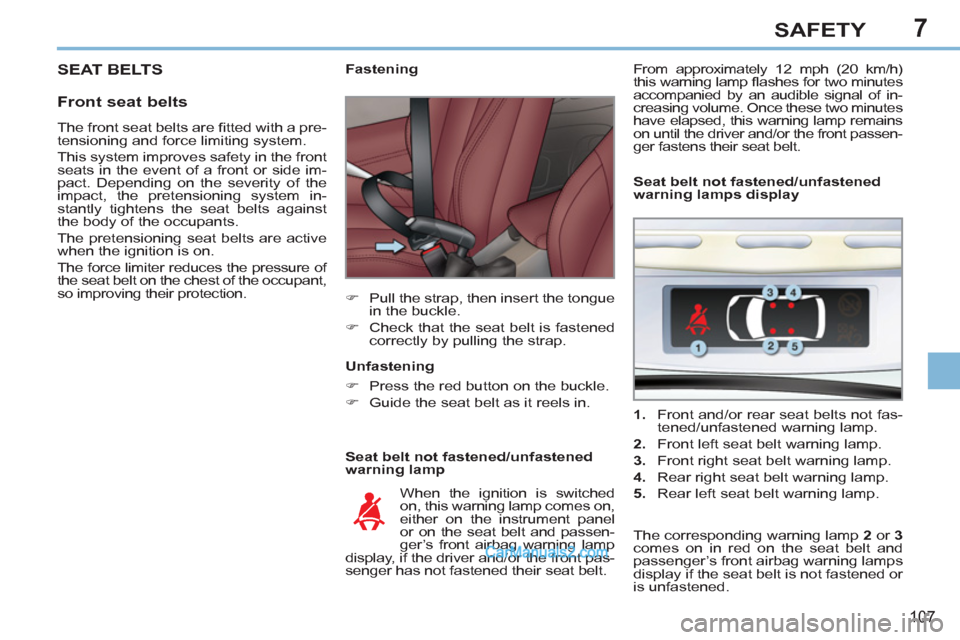
7
107
SAFETY
SEAT BELTS
Front seat belts
Seat belt not fastened/unfastened
warning lamp
Fastening
�)
Pull the strap, then insert the tongue
in the buckle.
�)
Check that the seat belt is fastened
correctly by pulling the strap.
When the ignition is switched
on, this warning lamp comes on,
either on the instrument panel
or on the seat belt and passen-
ger’s front airbag warning lamp
display, if the driver and/or the front pas-
senger has not fastened their seat belt.
Unfastening
�)
Press the red button on the buckle.
�)
Guide the seat belt as it reels in.
1.
Front and/or rear seat belts not fas-
tened/unfastened warning lamp.
2.
Front left seat belt warning lamp.
3.
Front right seat belt warning lamp.
4.
Rear right seat belt warning lamp.
5.
Rear left seat belt warning lamp.
Seat belt not fastened/unfastened
warning lamps display
The corresponding warning lamp 2
or 3
comes on in red on the seat belt and
passenger’s front airbag warning lamps
display if the seat belt is not fastened or
is unfastened.
From approximately 12 mph (20 km/h)
this warning lamp fl ashes for two minutes
accompanied by an audible signal of in-
creasing volume. Once these two minutes
have elapsed, this warning lamp remains
on until the driver and/or the front passen-
ger fastens their seat belt.
The front seat belts are fi tted with a pre-
tensioning and force limiting system.
This system improves safety in the front
seats in the event of a front or side im-
pact. Depending on the severity of the
impact, the pretensioning system in-
stantly tightens the seat belts against
the body of the occupants.
The pretensioning seat belts are active
when the ignition is on.
The force limiter reduces the pressure of
the seat belt on the chest of the occupant,
so improving their protection.
Page 110 of 292
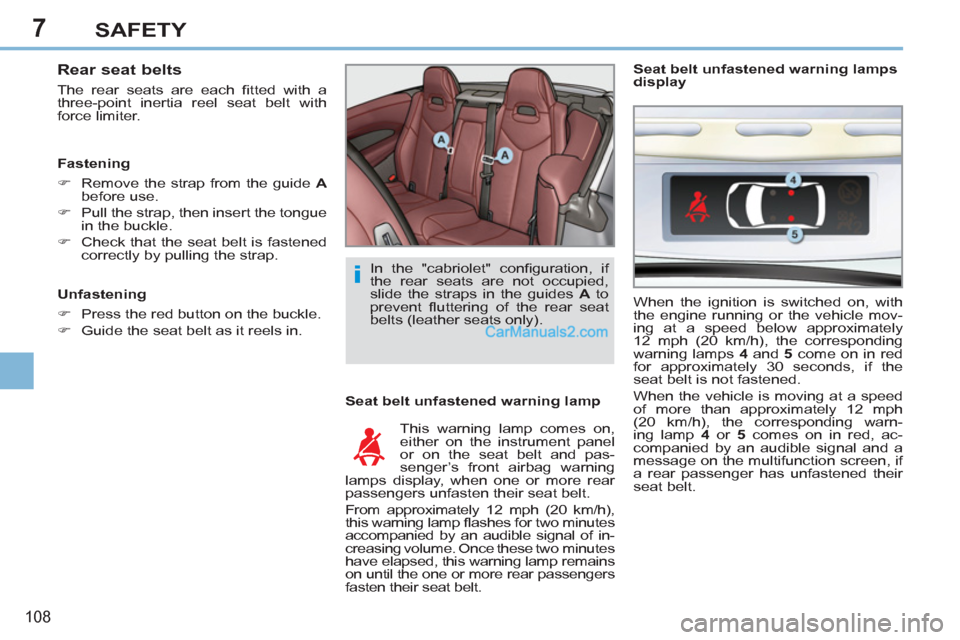
7
i
108
SAFETY
Rear seat belts
The rear seats are each fi tted with a
three-point inertia reel seat belt with
force limiter.
Seat belt unfastened warning lamp
This warning lamp comes on,
either on the instrument panel
or on the seat belt and pas-
senger’s front airbag warning
lamps display, when one or more rear
passengers unfasten their seat belt.
From approximately 12 mph (20 km/h),
this warning lamp fl ashes for two minutes
accompanied by an audible signal of in-
creasing volume. Once these two minutes
have elapsed, this warning lamp remains
on until the one or more rear passengers
fasten their seat belt.
Fastening
�)
Remove the strap from the guide A
before use.
�)
Pull the strap, then insert the tongue
in the buckle.
�)
Check that the seat belt is fastened
correctly by pulling the strap.
Seat belt unfastened warning lamps
display
When the ignition is switched on, with
the engine running or the vehicle mov-
ing at a speed below approximately
12 mph (20 km/h), the corresponding
warning lamps 4
and 5
come on in red
for approximately 30 seconds, if the
seat belt is not fastened.
When the vehicle is moving at a speed
of more than approximately 12 mph
(20 km/h), the corresponding warn-
ing lamp 4
or 5
comes on in red, ac-
companied by an audible signal and a
message on the multifunction screen, if
a rear passenger has unfastened their
seat belt.
Unfastening
�)
Press the red button on the buckle.
�)
Guide the seat belt as it reels in. In the "cabriolet" confi guration, if
the rear seats are not occupied,
slide the straps in the guides A
to
prevent fl uttering of the rear seat
belts (leather seats only).
Page 111 of 292
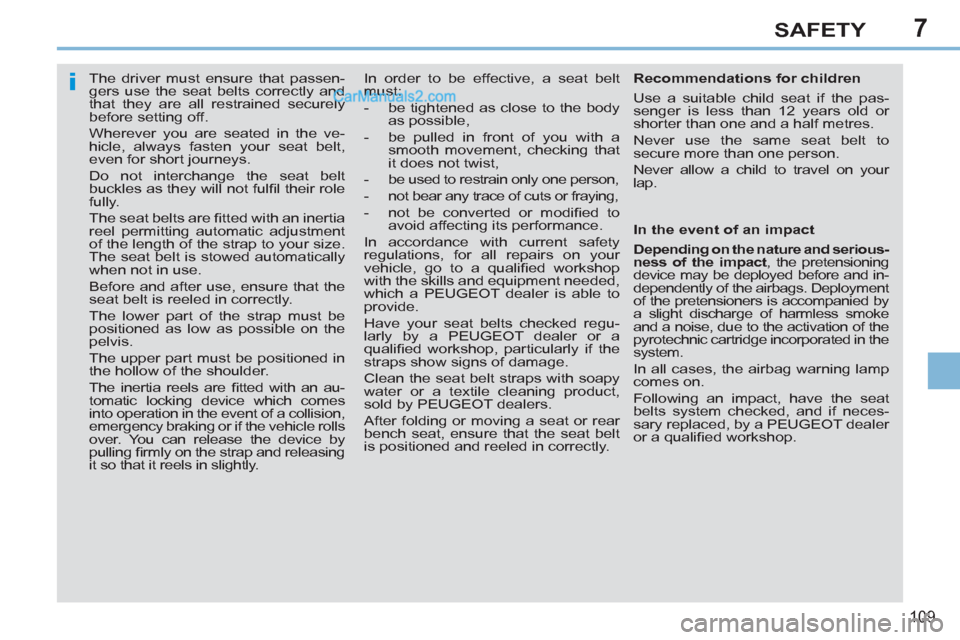
7
i
109
SAFETY
The driver must ensure that passen-
gers use the seat belts correctly and
that they are all restrained securely
before setting off.
Wherever you are seated in the ve-
hicle, always fasten your seat belt,
even for short journeys.
Do not interchange the seat belt
buckles as they will not fulfi l their role
fully.
The seat belts are fi tted with an inertia
reel permitting automatic adjustment
of the length of the strap to your size.
The seat belt is stowed automatically
when not in use.
Before and after use, ensure that the
seat belt is reeled in correctly.
The lower part of the strap must be
positioned as low as possible on the
pelvis.
The upper part must be positioned in
the hollow of the shoulder.
The inertia reels are fi tted with an au-
tomatic locking device which comes
into operation in the event of a collision,
emergency braking or if the vehicle rolls
over. You can release the device by
pulling fi rmly on the strap and releasing
it so that it reels in slightly. In order to be effective, a seat belt
must:
- be tightened as close to the body
as possible,
- be pulled in front of you with a
smooth movement, checking that
it does not twist,
- be used to restrain only one person,
- not bear any trace of cuts or fraying,
- not be converted or modifi ed to
avoid affecting its performance.
In accordance with current safety
regulations, for all repairs on your
vehicle, go to a qualifi ed workshop
with the skills and equipment needed,
which a PEUGEOT dealer is able to
provide.
Have your seat belts checked regu-
larly by a PEUGEOT dealer or a
qualifi ed workshop, particularly if the
straps show signs of damage.
Clean the seat belt straps with soapy
water or a textile cleaning product,
sold by PEUGEOT dealers.
After folding or moving a seat or rear
bench seat, ensure that the seat belt
is positioned and reeled in correctly.
Recommendations for children
Use a suitable child seat if the pas-
senger is less than 12 years old or
shorter than one and a half metres.
Never use the same seat belt to
secure more than one person.
Never allow a child to travel on your
lap.
In the event of an impact
Depending on the nature and serious-
ness of the impact
, the pretensioning
device may be deployed before and in-
dependently of the airbags. Deployment
of the pretensioners is accompanied by
a slight discharge of harmless smoke
and a noise, due to the activation of the
pyrotechnic cartridge incorporated in the
system.
In all cases, the airbag warning lamp
comes on.
Following an impact, have the seat
belts system checked, and if neces-
sary replaced, by a PEUGEOT dealer
or a qualifi ed workshop.
Page 113 of 292
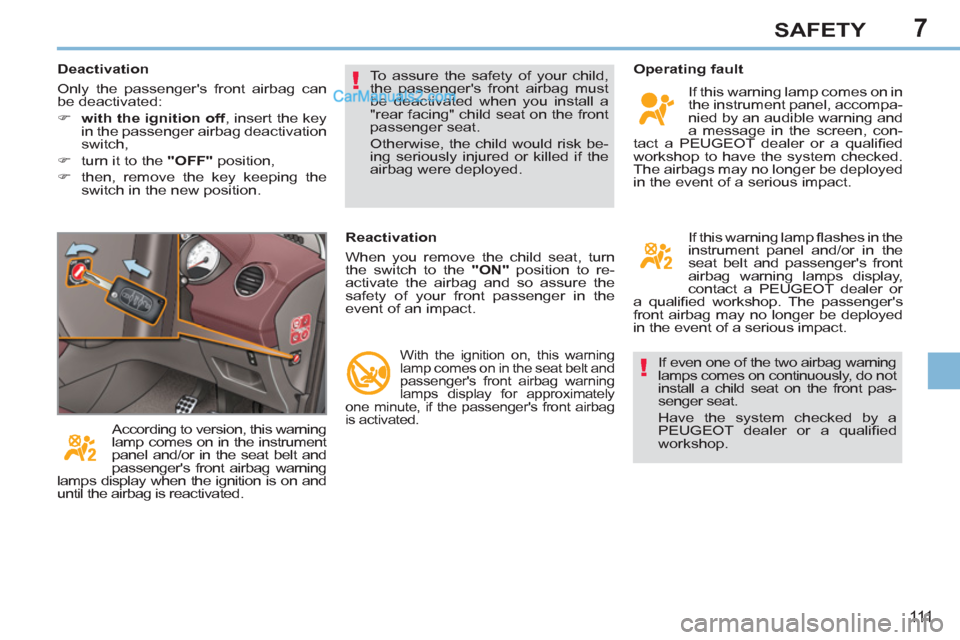
7
!
!
111
SAFETY
If even one of the two airbag warning
lamps comes on continuously, do not
install a child seat on the front pas-
senger seat.
Have the system checked by a
PEUGEOT dealer or a qualifi ed
workshop.
Operating fault
If this warning lamp comes on in
the instrument panel, accompa-
nied by an audible warning and
a message in the screen, con-
tact a PEUGEOT dealer or a qualifi ed
workshop to have the system checked.
The airbags may no longer be deployed
in the event of a serious impact.
Reactivation
When you remove the child seat, turn
the switch to the "ON"
position to re-
activate the airbag and so assure the
safety of your front passenger in the
event of an impact. With the ignition on, this warning
lamp comes on in the seat belt and
passenger's front airbag warning
lamps display for approximately
one minute, if the passenger's front airbag
is activated.
To assure the safety of your child,
the passenger's front airbag must
be deactivated when you install a
"rear facing" child seat on the front
passenger seat.
Otherwise, the child would risk be-
ing seriously injured or killed if the
airbag were deployed.
According to version, this warning
lamp comes on in the instrument
panel and/or in the seat belt and
passenger's front airbag warning
lamps display when the ignition is on and
until the airbag is reactivated. If this warning lamp fl ashes in the
instrument panel and/or in the
seat belt and passenger's front
airbag warning lamps display,
contact a PEUGEOT dealer or
a qualifi ed workshop. The passenger's
front airbag may no longer be deployed
in the event of a serious impact.
Deactivation
Only the passenger's front airbag can
be deactivated:
�)
with the ignition off
, insert the key
in the passenger airbag deactivation
switch,
�)
turn it to the "OFF"
position,
�)
then, remove the key keeping the
switch in the new position.
Page 114 of 292
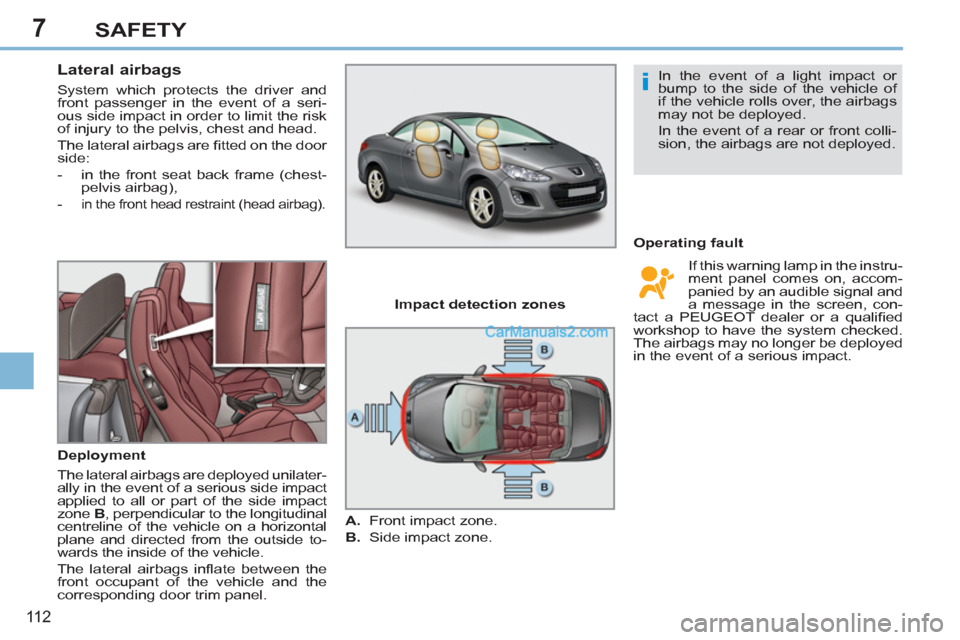
7
i
11 2
SAFETY
Lateral airbags
System which protects the driver and
front passenger in the event of a seri-
ous side impact in order to limit the risk
of injury to the pelvis, chest and head.
The lateral airbags are fi tted on the door
side:
- in the front seat back frame (chest-
pelvis airbag),
-
in the front head restraint (head airbag).
Deployment
The lateral airbags are deployed unilater-
ally in the event of a serious side impact
applied to all or part of the side impact
zone B
, perpendicular to the longitudinal
centreline of the vehicle on a horizontal
plane and directed from the outside to-
wards the inside of the vehicle.
The lateral airbags infl ate between the
front occupant of the vehicle and the
corresponding door trim panel.
Operating fault
Impact detection zones
A.
Front impact zone.
B.
Side impact zone. If this warning lamp in the instru-
ment panel comes on, accom-
panied by an audible signal and
a message in the screen, con-
tact a PEUGEOT dealer or a qualifi ed
workshop to have the system checked.
The airbags may no longer be deployed
in the event of a serious impact.
In the event of a light impact or
bump to the side of the vehicle of
if the vehicle rolls over, the airbags
may not be deployed.
In the event of a rear or front colli-
sion, the airbags are not deployed.